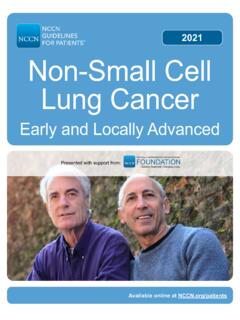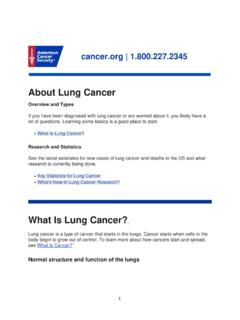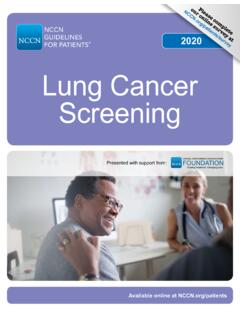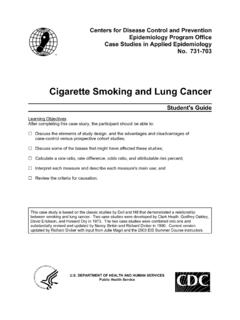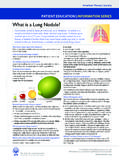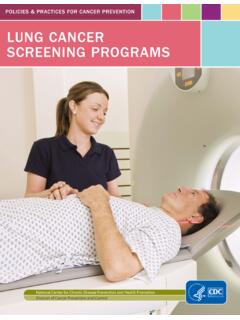Transcription of Implementing Timed Lung Cancer Diagnostic Pathway
1 OFFICIAL 2 Information Governance Statement Organisations need to be mindful of the need to comply with the Data Protection Act 1998, the Common Law Duty of Confidence and Human Rights Act 1998 (Article 8 right to family life and privacy). Equalities Statement Promoting equality and addressing health inequalities are at the heart of NHS England s values. Throughout the development of the policies and processes cited in this document, we have: Given due regard to the need to eliminate discrimination, harassment and victimisation, to advance equality of opportunity, and to foster good relations between people who share a relevant protected characteristic (as cited under the Equality Act 2010) and those who do not share it; and Given regard to the need to reduce inequalities between patients in access to, and outcomes from, healthcare services and to ensure services are provided in an integrated way where this might reduce health inequalities.
2 This information can be made available in alternative formats, such as easy read or large print, and may be available in alternative languages, upon request. Please contact 0300 311 22 33 or email stating that this document is owned by the NHS Cancer Programme, Operations & Information, NHS England. NHS England INFORMATION READER BOXD irectorateMedicalOperations and InformationSpecialised CommissioningNursingTrans. & Corp. & InnovationFinancePublications Gateway Reference:07924 Document PurposeDocument NameAuthorPublication DateTarget AudienceAdditional Circulation ListDescriptionCross ReferenceAction RequiredTiming / Deadlines(if applicable)ResourcesSE1 6LH0113 825 0000 NHS Cancer ProgrammeOperations and InformationNHS England90 London RoadRapid Diagnostic and assessment pathways illustrate how timely and effective care can be provided to patients presenting with Cancer symptoms.
3 Delivery of the pathways will support us to provide the highest quality care to our patients, and reduce variation in patient access to Diagnostic and treatment options. This handbook sets out how diagnosis within 14 days and diagnosis within 28 days can be achieved for the lung Cancer 18 April 2018 NHS England18 April 2018 CCG Clinical Leaders, CCG Accountable Officers, CSU Managing Directors, Care Trust CEs, Foundation Trust CEs , Medical Directors, Directors of Nursing, NHS Trust Board Chairs, NHS England Regional Directors, NHS England Directors of Commissioning Operations, Allied Health Professionals, GPs, NHS Trust CEs#VALUE!N/AN/AImplementation of pathways to deliver diagnosis in 28 days, in line with Refreshing NHS Plans 2018/19 Implementing a Timed lung Cancer Diagnostic pathwaySuperseded Docs(if applicable)Contact Details for further informationDocument is a controlled document.
4 Whilst this document may be printed, the electronic version posted on the intranet is the controlled copy. Any printed copies of this document are not controlled. As a controlled document, this document should not be saved onto local or network drives but should always be accessed from the intranet. OFFICIAL 3 Rapid Diagnostic and assessment pathways Rapid Diagnostic and assessment pathways World class Cancer care in England Rapid Diagnostic and assessment pathways illustrate how timely and effective care can be provided to patients presenting with Cancer symptoms. Delivery of the pathways will support us to provide the highest quality care to our patients, and reduce variation in patient access to Diagnostic and treatment options. This handbook sets out how diagnosis within 14 days and diagnosis within 28 days can be achieved for the lung Cancer Pathway .
5 We have identified useful resources that can support you with implementation, and have highlighted the key role of Cancer alliances in delivering large scale transformation across whole systems. The lung Cancer Timed pathways draw on the National Optimal Lung Cancer Pathway (NOLCP), which was produced by the NHS England Clinical Expert Group for Lung Cancer in August 2017 and sets out how to deliver the Pathway from referral to diagnosis. Clinical Expert Groups (CEGs) bring together clinical leaders who provide tumour specific clinical expertise. Their role includes ensuring that advice on best practice Cancer pathways is evidence-based and is available for anyone involved in the improvement of Cancer services. This includes Cancer alliances, commissioners, clinicians, managers, and patients This guidance complements existing resources such as NICE Guidelines (including NG12) and should therefore be read alongside such guidance.
6 The National Cancer Vanguard is a leader in developing and defining best practice Timed pathways. The Vanguard includes Greater Manchester Cancer , RM Partners, and the University College London Hospitals Cancer Collaborative. The faster Pathway outlined in this document has been drawn from Pathway redesign at University Hospitals of South Manchester. For any questions about this document please email the NHS Cancer Programme at Professor Chris Harrison National Clinical Director for Cancer Professor David Baldwin NHS England Clinical Expert Group for Lung Cancer Mr David Shackley Medical Director, National Cancer Vanguard System transformation The lung Cancer Diagnostic Pathway The case for change The request The benefits Timed pathways 28 day 14 day Additional information Audit tool Resources OFFICIAL 4 Rapid Diagnostic and assessment pathways World class Cancer care in England World class Cancer care in England The national Cancer strategy sets out an ambitious aim for the NHS to make significant progress in reducing preventable cancers, increasing Cancer survival and improving patient experience and quality of life by 2020.
7 Survival rates for Cancer in England have never been higher, and overall patients report a very good experience of care. However, we know there is more we can do to ensure patients are diagnosed early and quickly, and this will have a major impact on survival. We also know that patients continue to experience variation in their access to care, which needs to be addressed. Early diagnosis, fast diagnosis, and equity of access to treatment and care are central to the National Cancer Programme and the transformation of services we want to achieve by 2020/21. Faster Diagnosis Standard (FDS) We are Implementing a new Diagnostic standard for Cancer that emphasises the importance of receiving a diagnosis or ruling out of Cancer within 28 days. For patients who are diagnosed with Cancer , this means treatment can be offered earlier.
8 For those who are not diagnosed with Cancer , this communication of an all clear reduces the anxiety felt at a very stressful time. Cancer alliances are leading their local commissioners and providers to drive earlier and faster diagnosis. The rapid diagnosis and assessment interventions they are putting in place now will help to ensure the Faster Diagnosis Standard is met for patients when fully introduced from April 2020. The new Cancer Waiting Times system should be used to support the collection of the new faster diagnosis data items. This data can be used to audit how long it takes for patients to have their diagnosis communicated to them, and understand where to make improvements to shorten pathways. The focus is on reducing variation for patients and providing a consistent Timed Pathway .
9 Teams may improve beyond the pathways in this handbook, to radically shorten the Diagnostic time period further, building on local innovation to deliver sustainable pathways. The aim is to enable patients to have their diagnosis communicated to them in the shortest time possible, having experienced high quality care. E-referrals service (eRS) The NHS e-Referral Service is the process for referring all consultant-led first outpatient appointments from 1 October 2018. Resources for implementation are available on the NHS Digital website. System transformation The lung Cancer Diagnostic Pathway The case for change The request The benefits Timed pathways 28 day 14 day Additional information Audit tool Resources OFFICIAL 5 Rapid Diagnostic and assessment pathways System transformation World class Cancer care in England How to achieve success: Engage with patients throughout the Pathway redesign and implementation stages to ensure that changes will benefit your patients in terms of clinical outcomes and patient experience.
10 Ensure board or executive level sponsorship in each organisation to ensure prioritisation of Pathway implementation (board-level reporting of progress and Diagnostic performance) Establish a cross-system implementation team to enable access to limited resources, implement changes, overcome organisational divisions and structures, and avoid silo working. This could include GPs, consultants, clinical nurse specialists, Pathway navigators, Cancer alliance leads, and CCG and Acute trust leads ( contracts, IT). Identify clinical champions across the Pathway , across disciplines and departments, to ensure clinical leadership and endorsement on the ground. This can help you to quickly resolve problems, and develop and implement additional solutions to service challenges throughout implementation.










